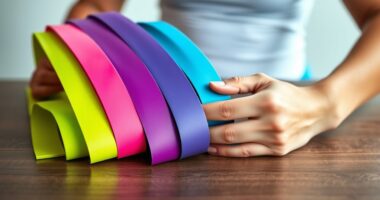To select the perfect yoga mat, consider your practice style, comfort, and safety needs. Choose eco-friendly materials like cork or natural rubber for sustainability. Opt for a thickness that matches your activity: thicker for restorative or thinner for stability and dynamic poses. Pay attention to grip and texture for slip resistance, and select a size and weight that suit your portability. Balancing durability, maintenance, and budget guarantees you get a mat that supports your practice long-term. Keep exploring for even more tips.
Key Takeaways
- Choose eco-friendly, biodegradable materials like cork or natural rubber for sustainability and durability.
- Select thickness based on your practice style: thicker for restorative yoga, thinner for dynamic or balancing poses.
- Prioritize slip-resistant textures and good traction to ensure safety during sweaty or challenging poses.
- Consider size and weight for portability and comfort, matching the mat to your height and practice space.
- Maintain your mat properly with regular cleaning and appropriate storage to prolong lifespan and hygiene.
Understanding Different Materials and Their Benefits
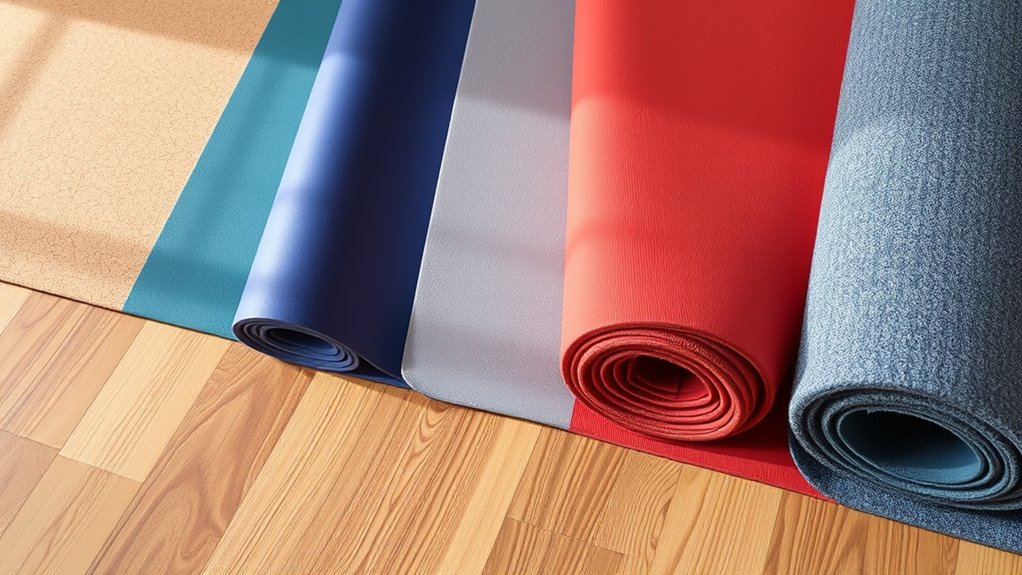
Choosing the right yoga mat starts with understanding the materials it’s made from, as each offers different benefits. Material sustainability is key; eco-friendly options like natural rubber and cork are renewable and biodegradable, reducing environmental impact. Synthetic mats, such as PVC or TPE, often involve manufacturing processes that can be less sustainable, but they tend to be more durable and affordable. When evaluating materials, consider how they’re produced—some manufacturing processes generate more waste or use harmful chemicals, affecting both the environment and your health. By understanding these differences, you can select a mat that aligns with your values and fitness needs. Prioritizing sustainable materials not only supports the environment but also encourages responsible consumption in your yoga practice. Additionally, material properties can help you choose a mat that provides optimal grip and comfort for your practice. Furthermore, advances in manufacturing processes are making eco-friendly mats more accessible and affordable for consumers.
Choosing the Right Thickness for Comfort and Stability
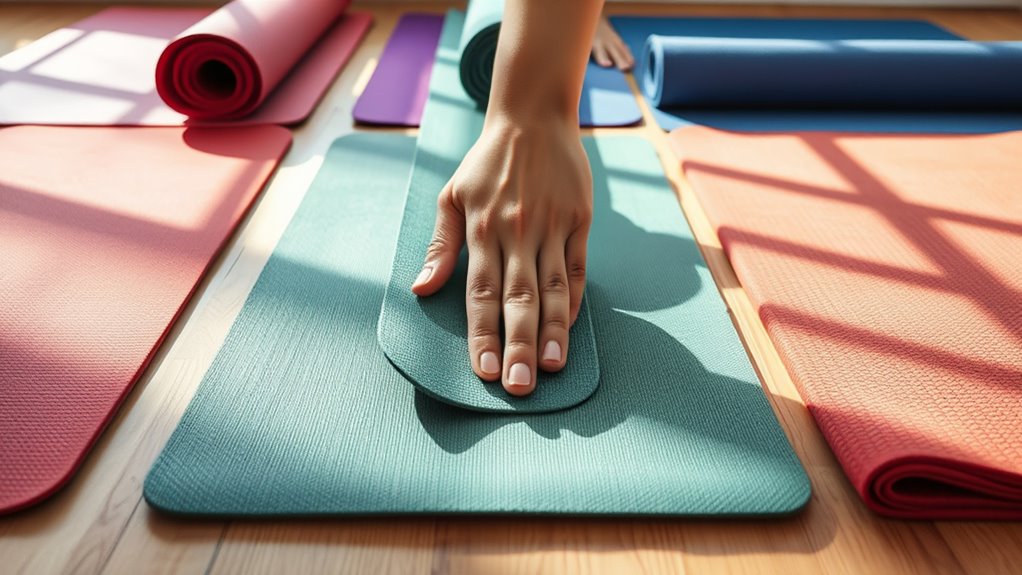
The thickness of your yoga mat directly influences how comfortable and stable your practice feels. A thicker mat offers more padding options, reducing pressure on your joints, especially during seated or kneeling poses. Conversely, a thinner mat provides greater stability for balancing poses and quick movements. Consider these factors:
- Thicker mats (4-6mm) enhance comfort but may sacrifice some stability.
- Thinner mats (1-3mm) improve balance due to less cushioning.
- Material flexibility varies; some mats compress more, affecting support and feel.
- Remember that seasonal variations can influence comfort levels, as colder temperatures may make thicker mats more appealing.
- AI content creation tools are transforming how yoga instructors develop class materials, offering innovative ways to engage students.
- Understanding credit card security measures can help you select mats with better durability and safety features, especially if you shop online for your yoga gear.
- Selecting a mat with non-slip features ensures safety during dynamic or sweaty practices, reducing the risk of slips and falls.
Your choice should align with your practice style and joint needs. Thicker mats are ideal for restorative yoga, while thinner ones suit dynamic flows. Understanding padding options and material flexibility helps you pick a mat that offers both comfort and stability.
Considering Texture and Traction for Safety
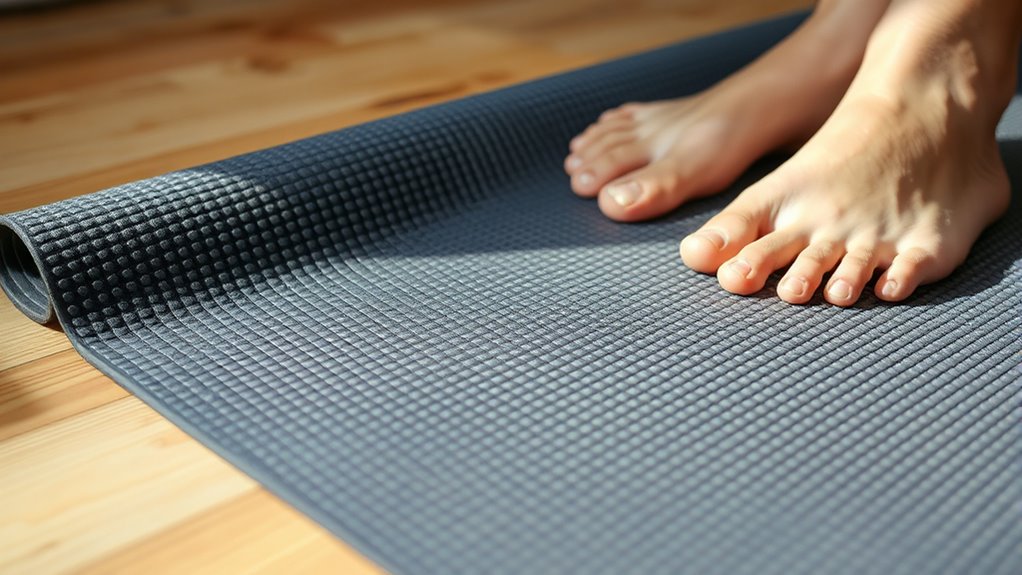
Your grip and how the surface feels under your hands and feet are vital for safety during practice. Look for mats with slip-resistant features to prevent accidents and guarantee stability. Choosing a surface with the right traction helps you maintain proper alignment and focus on your flow. Incorporating somatic awareness techniques into your practice can further enhance your connection to your body and improve your safety awareness during poses. Paying attention to traction qualities can also help you select the most suitable mat for your specific needs. Additionally, understanding AI in Business can inspire innovative features for future yoga mats, such as smart sensors that monitor grip and pressure. Considering natural materials in mat design can also promote a healthier practice environment and align with eco-conscious values.
Grip and Surface Feel
Since a secure grip is crucial for maintaining balance and preventing slips during yoga, paying attention to a mat’s texture and traction is essential. The surface feel influences how confident you feel during poses, especially in challenging positions. Look for texture options that promote grip enhancement without feeling abrasive. A well-designed surface provides consistent traction, helping you stay stable throughout your practice. Consider mats with textured patterns or raised surfaces that boost grip, even when your hands and feet sweat. These features improve control and safety, allowing you to focus on your flow. Remember, a good grip isn’t just about comfort—it’s about confidence and stability in every movement. Prioritize surface feel to ensure your practice remains secure and enjoyable. Additionally, understanding how sound vibrations can influence cellular regeneration might inspire you to incorporate calming sound elements into your practice environment for added relaxation, leveraging therapeutic benefits to enhance overall well-being. Incorporating texture design principles can further optimize grip performance and safety.
Slip Resistance Features
To guarantee safety during your practice, focusing on slip resistance features is essential, especially when it comes to texture and traction. An anti-slip surface helps prevent accidents, even when your hands or feet sweat. Look for mats with textured surfaces designed for traction, and assure they offer moisture resistance to maintain grip. A good slip-resistant mat balances grip and comfort, reducing the risk of slipping during poses. Consider these features to stay stable and confident throughout your session. Additionally, selecting a mat with appropriate material composition can further enhance its slip resistance and durability. Incorporating mats with non-slip surface textures that are designed for optimal traction can significantly improve your safety. Paying attention to material quality ensures that the mat maintains its grip over time and through various practice conditions. Recognizing the importance of AI-driven advancements in material science can also lead to better slip-resistant yoga mats in the future.
Selecting the Appropriate Size and Weight
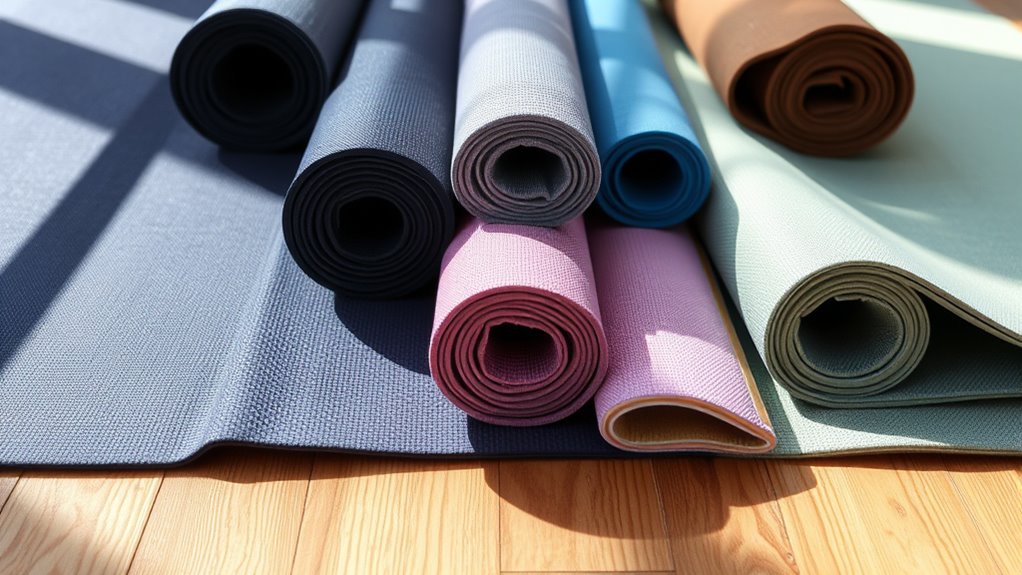
How do you choose the right size and weight of a yoga mat to suit your practice? First, consider your mat size; standard mats are about 68 inches long, but if you’re taller or want extra room, look for longer options. Next, think about weight options—lighter mats (2-4 pounds) are easier to carry around, perfect for travel or classes. Heavier mats (over 4 pounds) tend to be thicker and more stable, ideal for home use. To pick the best fit, consider these factors:
- Your height and preferred stretching space
- Portability needs for classes or travel
- Comfort and stability during poses
- Additionally, selecting a mat with suitable material and durability can enhance your practice and ensure long-term use. Understanding the self-watering plant pots options can inspire you to choose the best tools for consistent care and growth. Choosing a mat with proper grip and cushioning can also prevent slips and injuries, supporting a safe practice.
Evaluating Durability and Maintenance Requirements
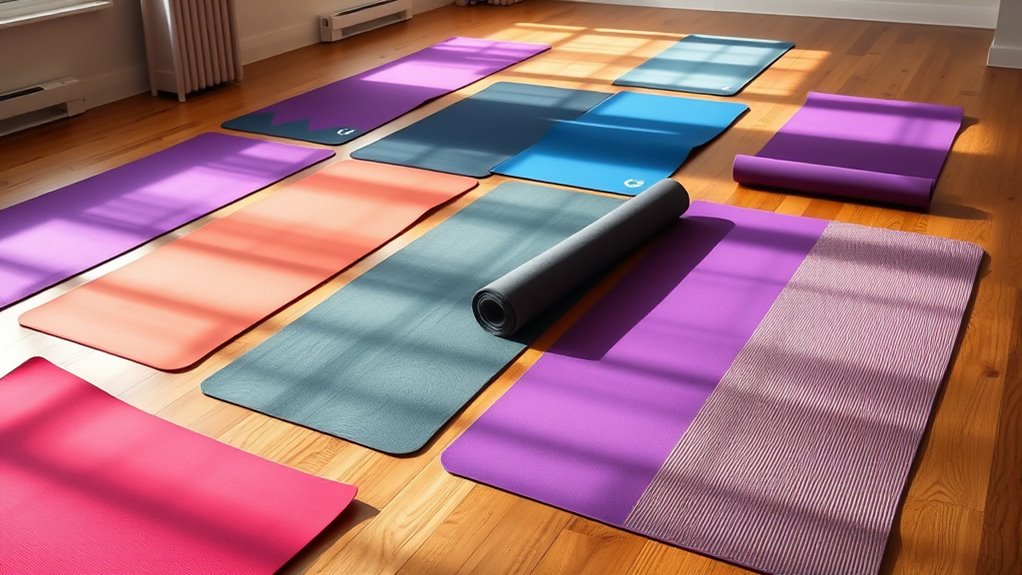
When choosing a yoga mat, it’s important to assess its durability and how easy it is to maintain. Look for materials that resist wear and tear from frequent use, like natural rubber or high-quality PVC. Consider cleaning routines needed to keep your mat fresh; some mats require simple wiping with a damp cloth, while others may need gentle soap and water. Proper storage solutions also extend your mat’s lifespan—roll it up and keep it in a cool, dry place to prevent damage. Check if the mat’s surface resists sweat absorption, which affects maintenance and longevity. A durable, easy-to-maintain mat saves you time and money, ensuring your practice remains safe and hygienic without constant replacement. Incorporating cleaning and maintenance techniques can further prolong your mat’s lifespan and keep it hygienic for regular use. Additionally, selecting a material with enhanced durability can significantly reduce the need for frequent replacements, especially if it utilizes advanced filtration technology found in air purifiers to maintain air quality during your practice.
Identifying Eco-Friendly and Sustainable Options
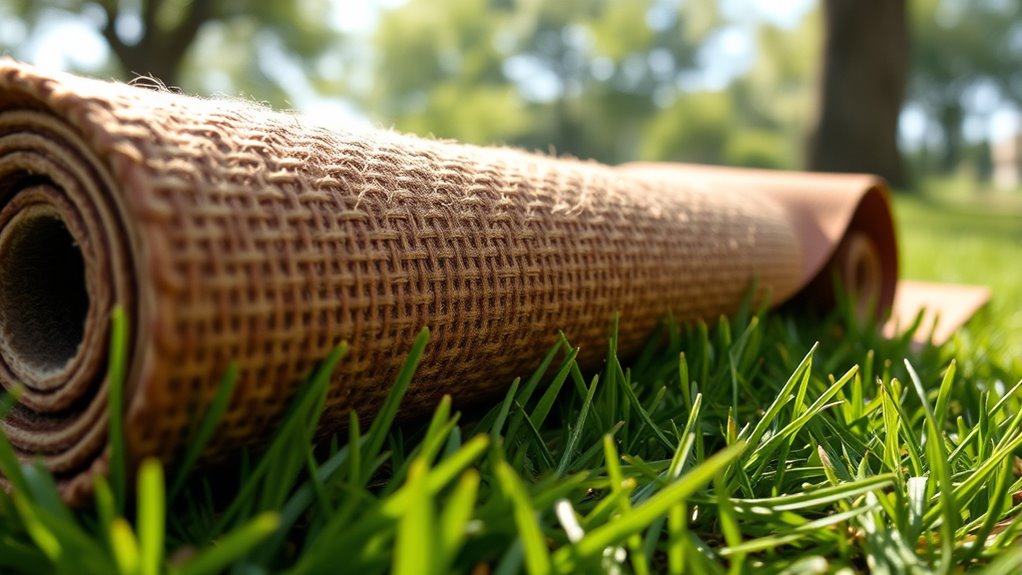
When choosing an eco-friendly yoga mat, focus on materials like natural rubber, jute, or cork that are sustainable and safe for the environment. Consider the durability and how long the mat will last, ensuring your choice supports both your practice and the planet. Also, look into brands that prioritize eco-conscious manufacturing processes to minimize environmental impact. Incorporating environmentally sustainable materials like chia seeds into your diet can further support your overall health and well-being. Additionally, selecting products that promote sustainable forestry helps ensure that your eco-friendly choices extend beyond just your yoga practice.
Eco-Friendly Material Choices
Choosing an eco-friendly yoga mat starts with understanding the sustainable materials available. You should look for biodegradable options and plant-based materials that minimize environmental impact. These materials typically come from renewable sources and break down naturally over time.
Some top choices include:
- Cork, known for its natural antimicrobial properties and renewability
- TPE (Thermoplastic Elastomers), a recyclable and often non-toxic alternative to PVC
- Jute and natural rubber, which are biodegradable and derived from plant sources
Durability and Longevity
To make certain your yoga mat lasts through countless sessions, focus on selecting options that are both durable and eco-friendly. A sturdy mat supports your yoga poses and enhances meditation benefits by providing stability and comfort. Look for materials like natural rubber or recycled foam, which resist wear and tear over time. Consider how well the mat withstands frequent use without losing grip or cushioning. Here’s a quick comparison:
| Material | Durability & Eco-Friendliness |
|---|---|
| Natural Rubber | High durability, biodegradable |
| Recycled Foam | Moderate durability, sustainable |
| Jute or Hemp | Very durable, eco-friendly |
Choosing an eco-conscious option ensures your practice remains sustainable while maintaining the mat’s longevity.
Eco-Conscious Manufacturing
Opting for eco-conscious manufacturing practices means prioritizing yoga mats made from sustainable and environmentally friendly materials. You’ll want to look for brands that use recyclable packaging to reduce waste and minimize your carbon footprint. Additionally, choosing mats produced with ethical labor practices ensures workers are treated fairly and work in safe conditions. To identify these options, consider these key factors:
- Materials like natural rubber, cork, or recycled plastics
- Packaging that’s recyclable or biodegradable
- Transparent supply chains emphasizing fair labor standards
Matching Your Budget With Quality and Features

Finding a yoga mat that fits your budget doesn’t mean you have to sacrifice quality or essential features. There are plenty of budget-friendly options that offer durability, good grip, and comfort without breaking the bank. Look for mats made from reliable materials like PVC or TPE, which often provide premium features at a lower cost. Consider how much cushioning you need—more padding isn’t always better if it compromises stability. Some affordable mats include non-slip surfaces and easy-to-clean designs, giving you great value for your money. Remember, a higher price doesn’t always guarantee better quality, so compare features carefully. With a little research, you can find a mat that balances affordability with the quality and features you require for your practice.
Testing for Comfort and Grip Before Purchasing
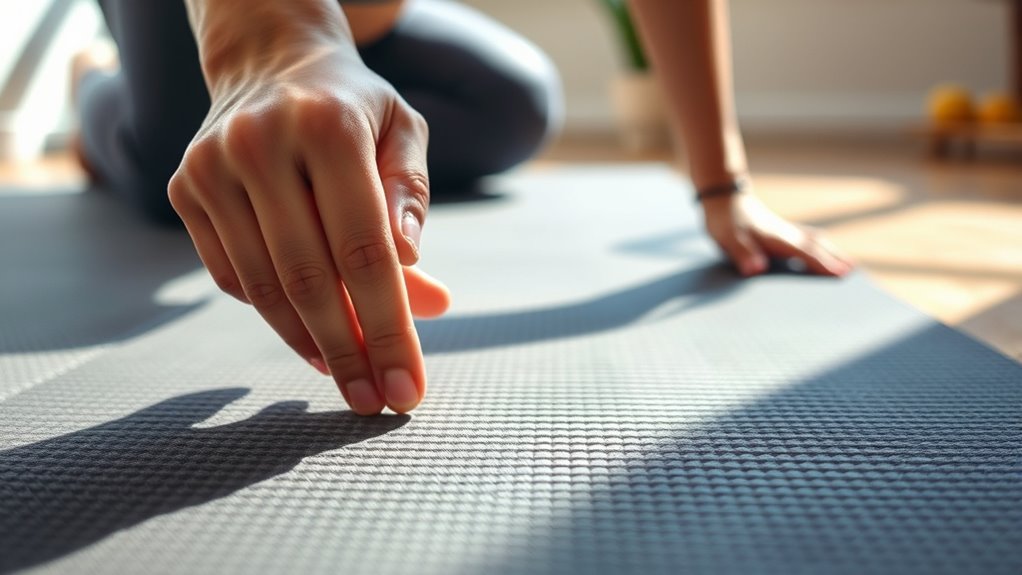
Before making a purchase, it’s essential to test a yoga mat’s comfort and grip to guarantee it meets your needs. You should feel how it supports your joints and ensures stability during poses. Check the breathability of the material—if it traps heat or sweat, it might become uncomfortable over time. Also, consider the aesthetic appeal; a mat that looks good can boost your motivation. To test these aspects, try these tips:
- Stand on the mat and simulate common poses to assess comfort and stability
- Swipe your hand across the surface to evaluate grip and texture
- Observe how well the mat breathes by noticing heat buildup or moisture retention
Doing this ensures you choose a mat that’s both functional and visually pleasing.
Tips for Caring for and Extending Your Yoga Mat’s Life
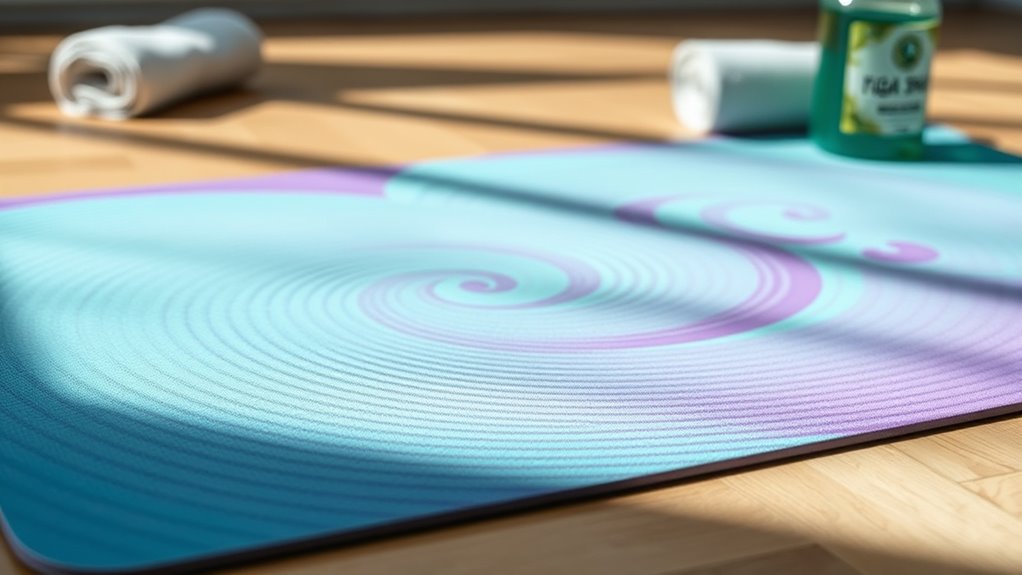
To keep your yoga mat in top condition and prolong its lifespan, regular cleaning and proper storage are essential. After each practice, wipe down your mat with a gentle, non-abrasive cleaner or a mixture of water and vinegar to remove sweat and dirt. Avoid harsh chemicals that can degrade the material. When not in use, store your mat flat or rolled in a cool, dry place to prevent warping or damage. Using mat storage bags or straps helps keep it protected and easy to transport. Avoid exposing your mat to direct sunlight or extreme temperatures, which can cause fading and deterioration. Consistent mat cleaning and thoughtful mat storage ensure your yoga mat remains sticky, clean, and supportive for many sessions to come.
Frequently Asked Questions
How Often Should I Replace My Yoga Mat?
You might wonder how often you should replace your yoga mat. Generally, the replacement frequency depends on mat durability and how often you practice. If your mat shows signs of wear, tears, or loss of grip, it’s time to get a new one. Regular use can wear down the surface, so replace it every 6 to 12 months for maximum support and safety. Keep an eye on its condition to guarantee the best practice.
Can I Use a Towel on My Yoga Mat for Extra Grip?
Using a towel on your yoga mat can be a good alternative grip solution, especially if your mat is slippery or you tend to sweat a lot. A towel provides extra traction and absorbs moisture, but it’s important to choose a towel versus mat that stays in place. Keep in mind, some towels can bunch up, so opt for one with a non-slip backing to ensure steady, safe practice.
Are There Mats Suitable for Hot Yoga or Sweaty Sessions?
Think of a yoga mat designed for hot yoga like a sponge soaking up sweat. These mats often feature high-quality material grip, preventing slips during intense poses. They’re made with sweat absorbency in mind, so you stay steady and confident. Whether you prefer natural rubber or other moisture-wicking materials, these mats help you stay safe and comfortable, even in the hottest, most sweaty sessions.
How Do I Store My Yoga Mat to Prevent Damage?
To prevent damage, you should consider proper storage solutions for your yoga mat. After mat cleaning, roll or lay your mat flat in a cool, dry place away from direct sunlight, which can degrade the material. Avoid folding it repeatedly, as this can cause tears. Store it in a breathable bag or container to protect it from dust and moisture, ensuring your mat stays fresh and durable for every session.
Are There Specific Mats Recommended for Beginners Versus Advanced Practitioners?
Did you know that 60% of beginner yogis choose mats based on price rather than material? For beginners, look for mats with excellent grip and cushioned support, often made from PVC or TPE. Advanced practitioners might prefer thinner, more durable mats with better grip for challenging poses. Material differences influence grip and comfort, so choose according to your skill level and practice intensity. Your mat should match your needs for safety and performance.
Conclusion
Choosing the right yoga mat might seem overwhelming, but once you consider your needs and preferences, it’s easier than you think. Don’t let price or material worries hold you back—there are options for every budget and eco-conscious choice. Remember, a good mat enhances your practice, not complicates it. Trust your instincts, test different options if you can, and enjoy your yoga journey with confidence and comfort. Your perfect mat is waiting!


